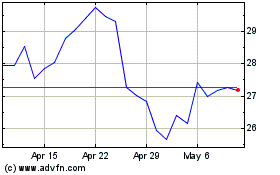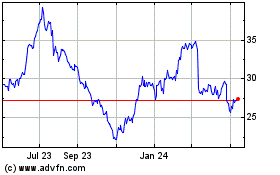Southwest Airlines Revamps Aircraft Order Book
June 23 2016 - 2:36PM
Dow Jones News
By Susan Carey
Southwest Airlines Co., finalizing a revamp of its fleet
strategy that began in 2012, on Thursday told investors it is
deferring delivery of Boeing Co.'s new 737-Max aircraft to take
fewer than earlier planned through 2022, in part to reduce its
near-term capital expenditure budget.
The nation's leading discount carrier has 330 Boeing 737s on
firm order for delivery through 2025, as compared with 328 through
2024, its previously reported delivery schedule. Its number of
planes on option remains the same. But the new plan will
significantly lower the number of new planes entering the fleet
from 2018 through 2022, Southwest Chief Financial Officer Tammy
Romo said at an investor day presentation Thursday.
This year and next, the Dallas-based carrier plans to boost
deliveries, in part to compensate for the previously announced
early retirement of about 50 older-version 737s by 2017. It will
add 67 planes in 2017, compared with the previously envisioned 61.
Some of the additional planes are used 737-700s Southwest has found
on the market at good prices. Others are new 737-800s it had on
firm order and the third tranche, starting next year, are Boeing's
new-engined version of the 737, the so-called Max-8.
Ms. Romo said the new fleet plan will defer $1.9 billion of
aircraft capital spending by 2020. Southwest's aircraft capex this
year will be $1.3 billion, rise next year and then retreat. Beyond
2020, the company will be able to keep that spending at manageable
levels, she said. The deferral of 67 firm deliveries over the next
several years supports the goal of 2% annual net fleet growth.
Southwest, which flies only variants of Boeing 737s, expects to
end this year with 723 planes in its fleet, a number that will dip
to 700 in 2017 before rising again to between 730 and 750 aircraft
in 2018.
Boeing, in a statement, said its strong 737 order book gave it
the flexibility to help Southwest accelerate deliveries in the near
term, then sequence its receipt of 737s over the longer term. The
manufacturer said it continues to see healthy demand in the
single-aisle aircraft market. Industry experts believe because the
Max model is in such demand, Southwest's deferrals in taking some
of those models could help Boeing work with other airline customers
who want to move up their delivery positions.
Bringing in the new planes will boost fuel efficiency and lower
maintenance costs, Ms. Romo said. In an earlier investor
presentation, she said the Max has 14% more fuel efficiency than
Southwest's 737-700s and 737-800s. The Max is about 20% more fuel
efficient that the 737-300s that are being retired.
The airline, No. 4 in the U.S. by traffic, had intended to
retire about 50 old-model 737s by mid-2018. But in January, it
moved up that date to the third quarter of 2017, so those planes
will be out of the system before it starts taking new Max-8 planes.
The decision to accelerate those retirements was made to alleviate
the need to have separate training regimes for the pilots.
Ms. Romo also said Southwest, which plans to add a new
reservation system in 2017, expects that IT cost to reach $500
million. But the benefits of the modern technology and new
functionality should allow the carrier to recoup that investment by
2020, she said.
Write to Susan Carey at susan.carey@wsj.com
(END) Dow Jones Newswires
June 23, 2016 14:21 ET (18:21 GMT)
Copyright (c) 2016 Dow Jones & Company, Inc.
Southwest Airlines (NYSE:LUV)
Historical Stock Chart
From Mar 2024 to Apr 2024

Southwest Airlines (NYSE:LUV)
Historical Stock Chart
From Apr 2023 to Apr 2024
